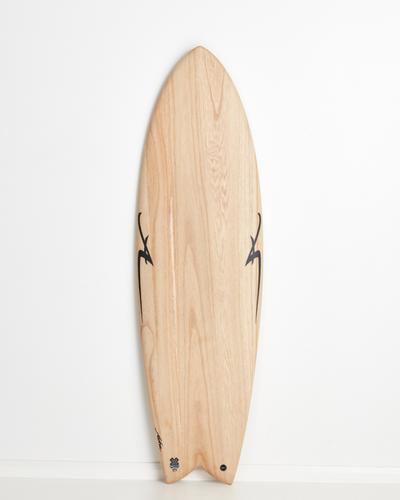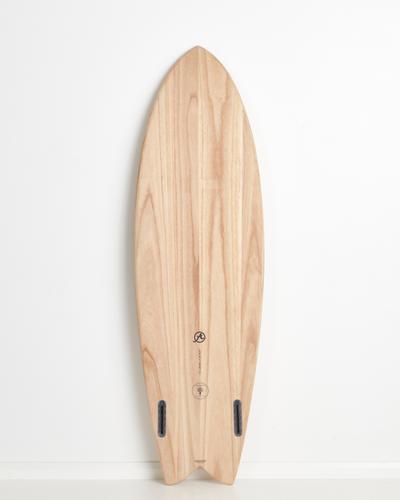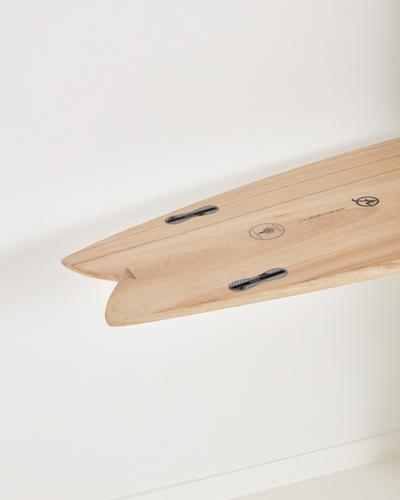Aloha Surfboards – Twin Fish – 5’8 / 5’10 / 6’0
€619.00 – €649.00
This little fish is short, wide and thick with a flat rocker principle for lots of fun plaining speed perfect for smaller waves. However, these boards can be extremely fun and functional in good quality waves and waves of size.
The classic twin keel fish was developed in the mid 70’s as a knee board by Steve Lis. Pintail surfboards were a favourite of his, but his swim fins would hang over the side creating drag. He decided to split the tail, giving him the width needed to support his fins, while still holding on to the performance characteristics of a pintail. This fish proved to be a barrel machine, able to paddle in early, take fairly late drops, hold high and tight in the pocket and was snappy off the top. It wasn’t long until he had refined the design to suit stand up surfers, and the fish design took off.
Description
Sizes:
| 5’8 |
20 1/2 |
2 3/8 |
33.74 |
| 5’10 |
20 3/4 |
2 1/2 |
36.88 |
| 6’0 |
21 |
2 5/8 |
40.16 |
– ECOSKIN Technology is a small step toward producing surfboards that are manufactured with more Earth friendly ethics.
Ecoskin surfboards are by no means sustainable but utilising less toxic materials during production we are taking steps to decrease our carbon footprint.
Paulownia is one of the fastest growing trees in the world, capable of growth rates of well over seven feet per year! Paulownia timber is perfectly suited as a sustainable alternative in surfboard production due to its lightweight and proportionately natural strength characteristics.
Some species of plantation Paulownia can be harvested for saw timber in as little as five years.
Once Paulownia trees are harvested, they regenerate from their existing root systems, earning them the name of the “Phoenix tree”.
Expanded Polystyrene (EPS) foam is very light and strong. EPS foam has more buoyancy and floatation increasing paddling speed and manoeuvrability
Epoxy Resin is a healthier alternative to polyester as epoxy emits 50-75% fewer VOCs, decreasing the amount of harmful chemicals released into the environment.
Brand
Aloha Surfboards
In 1978 ALOHA SURFBOARDS was started in Brookvale and the brand has never really looked back. Aloha picked up momentum very quickly and in a relatively short time was attracting positive support from an unprecedented number of world professionals. As a result the Aloha brand was set to march across most surfing territories over the next decade following the world tour, and with Greg still travelling and guest shaping in Japan and the US the brand was being exposed on all major surfing continents. Professional surfing has helped shape the Aloha ethos and has very much driven the design.

THERE ARE MANY ASPECTS TO SURFBOARD SELECTION THESE ARE THE POINTS TO CONSIDER
LENGTH
Typically surfboards are measured in inches. The length is measured from the nose to the tail. Choosing the length of the surfboard is dependant on your size (weight, height), board type and waves conditions you wish to use the board for.
WIDTH
The widest point of the surfboard is measured from rail to rail. Generally the wider the surfboard the more stable the board, while a board with smaller width maintains better speed and performance.
BOARD THICKNESS
Surfboard thickness is measured from the top deck to the bottom. The thickness again has a bearing on the board’s performance. Professional surfers will tend to go for the thinner boards as they are lighter and offer better performance.The thicker boards are stronger and because there is more foam under the surfer the boards are more stable.
ROCKER
The bottom curve of a surfboard. Generally the more rocker the surfboard has the more loose (manoeuvrable) the surfboard will be. Where the flatter rocker surfboards will be faster, although they will lack the looseness. The nose is the tip of the surfboard, the nose can vary in shapes and size. Basically the thinner the nose the more response the board will perform, while wider noses are better for stabilization.
STRINGER
Used to increase the strength of a surfboard, a stringer (normally made from wood) runs down the length of a surfboards (typically in the centre of the board from the tip of the nose to the tail).
Boards built with Epoxy, Carbon Fibre and soft boards generally don’t have stringers.
FINS
Generally heavier surfers require larger fins to hold the waves better. Although if you prefer to ride a looser (less hold in the waves), smaller fins would be a better option.
FIN CONSIDERATIONS
Fin configurations have an effect on the ways your surfboards perform.
The following are some of the more common fin configurations.
SINGLE FIN
The single fin was the original fin configuration for surfboards. Based on the idea of the sailboat keel. Single fins are added stabilization and control on the powerful, larger waves, although lack manoeuvrability
TWIN FIN
Are great for small waves, being fast and manoeuvrable, but when put into tight spots on larger waves, they become hard to control. Popular with Fish surfboards.
THRUSTER 3 FIN
Widely recognized as the standard fin configuration, the thruster answers the shortcomings of the single fin and the twin fins configurations.
The thrusters give you stabilization, control and manoeuvrability in all types of surfing conditions.
This concept was the brainchild of Australia’s Simon Anderson
QUADS 4 FINS
With four fins in the water, Quads boasts an extraordinary amount of holding power in larger surf.
You may think that having four fins would sacrifice speed by creating more drag, but this is not the case.
The both sets of fins are working together on the rail, which makers believe they creates less drag than a board with a centre fin.
The manoeuvrability isn’t sacrificed either, with fins directly under your back foot, the quads are very responsive.
KEEL
Similar setup to the Twin Fin, although smaller (low profile) fins are generally placed wider (closer to the rails) on the surfboard.
Popular with Fish and Egg / Retro surfboards.
Heeft u hulp nodig bij uw aankoop? Neem dan gerust contact met ons op
+3170 201 5153
info@noordzeeboardstore.nl
Contact formulier






